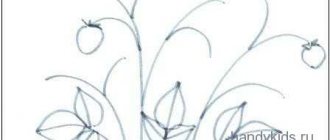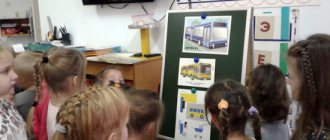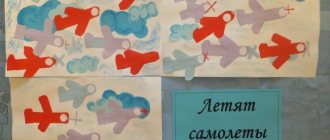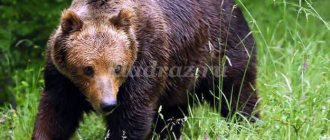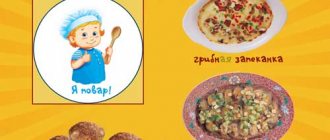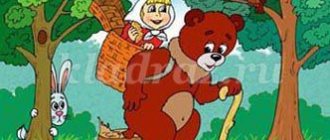Preview:
Summary of GCD in the middle group
Theme: “Fairytale tree”
Educational field "Artistic and aesthetic development"
Goal: to exercise the ability to convey the correct structure of a tree. Software tasks.
Developmental: develop a sense of color, rhythm, imagination, fine motor skills; expand children's vocabulary.
Educational: to cultivate interest in drawing using non-traditional techniques; cultivate neatness and kindness towards each other; induce in children an emotionally positive attitude towards nature.
Preliminary work: looking at trees in kindergarten, looking at illustrations depicting fairy-tale trees, reading K. Chukovsky’s poem “The Miracle Tree”.
Educator: Children stand in a circle, perform movements according to the text:
Hello, right hand,
Hello left hand,
Hello, our cheerful circle!
— Good morning everyone!
— Guys, this morning the postman brought a letter from a bear cub to our art workshop. What happened to him? Let's read it.
“In autumn, all the leaves fall off the trees. It’s becoming empty and ugly around my den. I know that the guys can draw magical trees that can delight me all year long. Help me please!".
Educator: Shall we help the bear cub? Now we will draw magic trees, and the little bear will plant them near his house. Do you agree?
Think about where we start drawing a tree?
Children: Branches Educator: Correct. They grow from the trunk. The lower ones are longer than the upper ones. Large branches have small twigs.
- Guys, did it turn out to be a tree?
Educator: To make a fairy-tale tree, what color paints will we use to depict the leaves and fruits?
Children: Yellow, red, orange, blue, etc.
Educator: Guys, we will draw fruits and leaves in an unusual way - with our fingers. My tree is ready, but note that the image of the tree takes up almost the entire sheet of paper, but does not extend beyond the edge of the sheet. Before we start drawing a fairy tree for our little bear, we need to stretch our fingers.
"Gymnastics for fingers"
Here are my assistants, turn them any way you want: (Rotate your hands)
And this way, and this way, they won’t be offended in any way. (Rub with hands)
One two three four five. (Clap)
Turned it around. Turned it around. (Circular rotations with a brush)
And they wanted to work. (Rub with hands)
Now let's go to the tables and start drawing.
The children take their seats. The teacher helps children in the process of work with leading questions, advice, showing them to those who need it, and receiving images.
Educator: That's how many beautiful, colorful trees our little bear will now grow near the house. When the works are dry, we will mail them to the bear cub.
Educator: Guys, what did we draw? What did we draw today?
Miracle tree
Vasilyeva Alevtina Petrovna Naumova Galina Petrovna teachers MBDOU “Kindergarten No. 11 “Rucheyok” of a general developmental type with priority implementation of activities for the artistic and aesthetic development of children” in the city of Cheboksary, Chuvash Republic
MIRACLE TREE summary of organized educational activities for children of the middle group
Educational field: “Artistic and aesthetic development.”
Type of children's activity: “Perception of artistic art. Visual activity."
Advertising message
Age category: middle group children.
Integration with other areas: “Speech development”, “Cognitive development”, “Socio-communicative development”.
Program content:
- Educational objectives:
- Teach children to create a fabulous image of a tree in a drawing.
- Continue to introduce non-traditional drawing materials.
- Developmental tasks:
- Development of prerequisites for the value-semantic perception of the natural world;
- Develop creative imagination, the choice of image methods and visual material depending on the conveyed image;
- Develop children's thinking, imagination and curiosity.
- Educational tasks:
- To cultivate responsiveness, goodwill, to evoke positive emotions in children, to bring joy to children.
- To cultivate aesthetic taste and accuracy in performing work.
- Vocabulary work: explain to children the concepts: artist, tripod easel.
- Individual work: to activate inactive children: Lesha I, Artema D., to help formulate their ideas, guesses, hypotheses.
- Preliminary work:
- Reading the fairy tale by K. I. Chukovsky “The Miracle Tree.”
- Examination of illustrations, “Miracle Tree”.
Equipment: Illustrations for the fairy tale “The Miracle Tree”, pictures of trees, felt-tip pens, magic brush (prop), audio recording of classical music; drawing materials: sheets of white A5 paper, paste, brushes, PVA glue, gouache, water in cups, cotton swabs, felt-tip pens, pencils, crayons, colored sand, plasticine, watercolor, palette, millet.
Move.
Introductory part (Children playing in a group)
Educator : - Look, guys, what an interesting book Sophia is considering, you and I have already read it. Who remembers what the book says and who its author is?
Children: - “The Miracle Tree”, and it was written by Korney Ivanovich Chukovsky.
Educator : -How did you guess that this is a miracle tree? (children's answers).
Slide No. 1 (The ball flies).
Educator : -Guys, a ball has arrived to us. Look, there is something attached to it. This is a letter, and guess who wrote it using the riddle.
Slide № 2
I have a pencil, Multi-colored gouache, Watercolor, palette, brush, And a thick sheet of paper, And also a tripod easel, Because I...
Who is an artist? What does an artist do? (children's answers). What does an artist have? What does the artist paint on? Why is it called a tripod?
I suggest reading the artist's letter.
Slide № 3
“Amazing trees grew in a wonderful forest. There was a disaster on the island; all the trees disappeared somewhere. Animals and birds were left without shelter. And everything went dark around. Please help me draw wonderful trees so that the island will once again sparkle with beauty and magic, so that birds and animals can return home. I can’t do it alone, so I wrote you this letter.”
How do you think we can help the Artist? (Children's answers).
Now I will touch each of you with the magic brush that the artist sent us, and you will turn into a miracle - artists, and you and I will find ourselves in a creative workshop.
1, 2 ,3 ,4, – Everyone has turned into artists!
Artists use various materials to paint. I suggest you come to our workshop and choose what you need for work.
-What might your “miracle tree” look like? (It may be similar in shape to birch, oak, and maple).
-What should a tree be like so that there is plenty of space for birds and animals? (It should be lush and spreading).
-Anya, what materials will you use to depict the tree? Andrey, what kind of tree will you draw?
Kostya, what will your tree be like? (Children's answers).
-Think about where we start drawing a tree? (We will start drawing the tree from the trunk).
- Right. What else needs to be drawn to make a tree? (Branches).
That's right, branches.
(Knock on the door, entrance of the toy artist).
- Guys, someone is knocking on our door, I suggest you take a look. This is an artist! He came to us not alone, but with a magical Christmas tree. The artist painted such a beautiful Christmas tree. She is very cheerful and wants to play with you.
- Guys, let's play?
Physical exercise “Christmas tree”.
Slide № 3
Educator: -Well done, now I suggest you sit down and continue your work.
I wish you good luck and creative works. Don’t forget to keep your back straight while drawing and not disturb the children sitting next to you. Let's get started.
Artist: -What wonderful trees you make. Well done!
Slide № 4
(Children work independently to calm music).
Artist: -That’s how many beautiful, colorful trees our birds and animals will now have.
Artist: -I suggest wandering through the fairy-tale forest, admiring the unusual trees of other children. Who wants to talk about their tree? What material did you use for painting? (Children talk about their tree, give it characteristics, for example, this is the tallest and densest tree, birds will settle on it. And on this tree there is a hollow for a squirrel).
The final part.
(The artist proposes to make an exhibition of trees on stands).
Artist: - Thanks, guys. What a magical, wonderful forest we have. We will protect the trees. Why do we need to protect trees? (They decorate our nature, make the air clean).
Artist: - Guys, what did you like most today? What material did you use to draw the miracle tree? What grows on your trees?
And I, guys, will tell you that you are not only real artists, you are also great, you did a good deed today - you helped birds and animals find a home.
I completely forgot, I brought you colored pencils so that you could draw just as beautifully.
Children: - Thank you!
Artist: - Thank you, guys. Goodbye! Syvă pulăr, now! (leaves).
Children: - Syvă pulăr!
Educator: -Well done, guys! What would you like to draw in your next lesson? (children's suggestions). Okay, we'll wait for the next lesson.
On the topic: methodological developments, presentations and notes
Topic: “Magic Tree” Goal: Consolidation of the material covered Objectives: Educational: - Strengthen children’s understanding of geometric shapes; ability to recognize geometric shapes by touch: circle.
The summary was compiled for an average mixed-age group (most children are 4-5 years old).
Integration of OO: Tasks: “Cognition” - consolidate knowledge about the parts of the day, the ability to distinguish and name the seasons; consolidate knowledge about numbers from 1 to 5, the names of geometric shapes (circle, oval.
Learn to cut strips of colored paper in green, red, yellow into squares.
Developing the ability to round corners and cut straight.
Source
Summary of GCD for drawing in the middle group “Fairytale Tree”
Svetlana Sergeevna Khatko
Summary of GCD for drawing in the middle group “Fairytale Tree”
Khatko Svetlana Sergeevna
Abstract of educational activities on the public organization “Artistic and aesthetic development”
(
drawing ) in
the middle group on the topic “
Fairytale tree ” .
Goal: to consolidate “ finger painting ”
, technical skills.
Developmental: develop a sense of color, rhythm, imagination, fine motor skills; expand children's vocabulary.
Educating: to evoke in children an emotionally positive attitude towards nature in the fall through the use of literary words; cultivate interest in drawing using non-traditional techniques; cultivate neatness and kindness towards each other.
Materials and equipment: sketch with the stage of drawing a tree , palette with paint, wet wipes, brushes, jars of water, autumn leaves, letter.
HE. Mishchuk. Drawing lesson on the topic “Fairytale trees for Dunno from the Flower City”
Author's summary of a drawing lesson in the middle group
Create a fairy tale in a child's life, and it will awaken the magical strings of his soul.
| Organizational educational activities | ||
| Kind of activity | Topic/Materials | Objectives/Program content |
| Drawing | “Fairytale tree” Materials. Gouache, sheets of paper, brushes, jars of water. | Learn to depict the image of a fairy-tale object. Learn how to draw and paint a tree correctly. Develop imagination. |
| Lesson stage | GCD content | |
| Preliminary work | To consolidate knowledge about the structure of a tree and the understanding that a fairy-tale tree also has a trunk and branches, however, leaves and fruits can be magical, unusual, different from real ones. | |
| Main part | Conversation with children The teacher tells the children that an unusual guest came to their lesson. I’ll tell you a riddle, and you try to guess what kind of guest came to us. Riddle about Dunno. In a hat with a round brim and in knee-length pants, busy with various things, he’s just too lazy to study. He is a famous artist, He is a well-known poet, He is wonderfully brought up, He is dressed very well. Who is he, quickly guess! What is his name?.. (Dunno from Flower City). - Guys, do you remember from which fairy tale this little man came to us? (Children's answers). The teacher reads an excerpt from the first chapter of “Shorties from the Flower City” of N. Nosov’s fairy tale “The Adventures of Dunno and His Friends.” The teacher asks questions about the fairy-tale city in which very small children and toddlers lived. Everything they had in this city was unusual (boats made of birch bark, Cucumber River, Daisy Alley, Vasilkov Boulevard). After the discussion, the teacher continues to tell the invented story. The teacher says that one day all the residents of the amazing town gathered in the main square and decided that they needed a magical park in which they could walk, but fabulous trees should grow there. The shorties discussed for a long time what kind of trees should be in this park, and finally, the main and smart little shorty named Znayka, whom everyone listened to in this city because he read a lot and was very smart, said: “Since We live in the Flower City, then trees with fabulous flowers of extraordinary beauty should grow in our park.” All the babies and toddlers loved this idea because they loved flowers so much. They began to think where they could get such magical trees. They thought and thought and decided to send Dunno to look for them around the world. Dunno wandered around different countries for a long time, but nowhere did he find such trees, and so he stopped by to see us because he heard that our children can draw and imagine very beautifully. - Guys, let's help Dunno and all the residents of the Flower City and draw fabulous trees on which amazingly beautiful flowers will bloom? (Children's answers). Dunno will take them with her, and together they will make their own magical park out of them. Explanation of the drawing scheme. | |
| Physical education minute | Gymnastics with Dunno Here's Dunno's exercises. Do it in order. Get up quickly, smile, Stretch higher, higher. Come on, straighten your shoulders, raise them, lower them. They turned to the left, to the right, Hands touched with knees. We sat down and stood up, We sat down and stood up, I hope you are not tired? You need to stand up freely and breathe more calmly. | |
| Final part (summarizing) | Let's see what amazing trees you have made. Do you like your drawings? Dunno is also delighted with your work, he is sure that all residents of the Flower City will like the trees, since very beautiful flowers have bloomed on them and they will now have a magical park in their town. Insertion of children's works. | |
Step-by-step description of the work execution scheme
The teacher should pay special attention to explaining all the stages of drawing a fairy tree:
- Children place the album sheet vertically.
- A tree consists of a trunk and branches. They begin to draw from the top with the tip of the brush, and since the trunk expands at the bottom, gradually, approaching the base of the trunk, we place the brush flat. The brush must be held without stopping.
- We draw branches, main and additional. The main branches extend from the trunk. We direct them upward, you can make them slightly curved. Thin branches grow on the main branches; they can be directed in different directions from the main branches.
- Flowers can be drawn using different techniques—dipping, poking—depending on the children’s intentions.
Stages of drawing a tree
Pictures to show children
Illustrations for the fairy tale “The Adventures of Dunno and His Friends”
From the fairy tale “The Adventures of Dunno”
From the fairy tale “The Adventures of Dunno”
From the fairy tale “The Adventures of Dunno”
From the fairy tale “The Adventures of Dunno”
From the fairy tale “The Adventures of Dunno”
From the fairy tale “The Adventures of Dunno”
Progress:
All the children gathered in a circle,
Let's hold hands together
And let's smile at each other!
So you and I greeted each other, and now listen to the riddle and determine what time of year it talks about:
Leaves fly off the branches,
Birds fly away to the south.
“What time of year is it?”
- we’ll ask.
Educator: correct, what changes occur in nature in the fall?
Children: the leaves are turning yellow, it’s raining, it’s getting cold, birds are flying to warmer places, etc.
Educator: Guys, we received a letter today (reads the letter)
In a certain kingdom, in a distant state, there lived Tsar Demyan. And he had a garden so rich that a better garden could not be found in any kingdom. Various expensive trees , and there was one apple tree there that brought golden apples. But trouble happened: the Firebird flew into the garden and nibbled all the golden apples. The king was saddened and asks for help to revive the garden, and for this he needs paintings with painted apple trees .
Summary of the drawing lesson “Fairytale Tree” in the middle group
Lyudmila Dudnyak
Summary of the drawing lesson “Fairytale Tree” in the middle group
Goal: to exercise the ability to convey the correct structure of a tree . Software tasks.
Developmental: develop a sense of color, rhythm, imagination, fine motor skills; expand children's vocabulary.
Educators: cultivate interest in drawing using non-traditional techniques; cultivate neatness and kindness towards each other; induce in children an emotionally positive attitude towards nature.
Materials and equipment: pencils, 1/2 album sheet. letter.
Preliminary work: looking at trees in kindergarten , looking at illustrations depicting fairy-tale trees , reading K. Chukovsky’s poem “ The Miracle Tree ”
.
Development of middle-aged children by means of drawing
At the age of 4–5 years, preschoolers begin to form an aesthetic attitude towards the world, they begin to understand the beauty of natural phenomena, interiors, and exteriors. At this stage of development, both the teacher and parents must cultivate artistic taste, introduce them to art, teach them not only to look at illustrations, paintings, sculptures, and their own works, but also to evaluate them from the position of correctly conveying the form, color palette, mood, and characteristic features.
Organization of a drawing training system
There must be continuity in the education system. This means that before starting to draw or sculpt any objects, children must have basic knowledge about them, which they receive in classes to familiarize themselves with the outside world, on walks while observing natural phenomena (snow, rain, dew , wind) and objects (soil, trees, flowers, herbs, birds, insects). Thus, previously acquired knowledge will help children better convey the image, its features, and character. In addition, visual activities contribute to the development of artistic taste and skill, harmoniously developing the child’s personality.
In middle preschool age, children take their first steps in composing and thinking through a composition. First, the teacher offers different options for plot compositions, gradually introducing individual elements into the children’s work that would decorate the image and create the integrity of the image. In the process of acquiring the skill of composing a composition, children begin to independently arrange parts of the drawing, applications on a sheet of paper, and think through details that could decorate their work. All this develops the imagination and creative thinking of children.
Drawing techniques and additional types of visual activities
In drawing classes, you can use traditional drawing techniques using colored pencils, wax crayons, gouache, and watercolors. You can combine drawing media: watercolor and wax crayons. Among the non-traditional techniques, finger painting, blotography, and poking may be interesting.
The theme “Fairytale Tree” allows you to develop interest in various types of visual activities, that is, along with drawing, the teacher can use modeling, for example, on the theme “Gifts of the Fairytale Tree”, and application on the theme “What fairy tale is our tree from?”, “On fruits and vegetables grew on the fairy tree.” Much also depends on the imagination of the teacher, because only a person with a rich inner world and a pedagogical spark can captivate children into the world of creativity and teach them to create.
The teacher can offer individual tasks to children who show special interest and ability in drawing. For example, draw a fairy-tale tree with unusual fruits, using non-traditional drawing techniques (stamping, finger painting), with colorful leaves (color prints of natural leaves of trees or shrubs). Children should find the idea of using semolina when suddenly such a tree has grown in a fairy-tale winter forest, or colored sand, with the help of which they can add texture to the gifts of a fairy-tale tree. This kind of assignment turns a learning session into a real creative process, and the children feel like artists.
Themes of collective and individual compositions
The topic of drawing a fairy-tale tree is studied after mastering the drawing topics “Draw a picture about summer”, “Apples are ripe on the apple tree”, “Beautiful flowers”, modeling “Apples and berries”, “Big and small carrots”, “Vegetables and fruits”. Thus, children already have an idea of how to depict a tree, various vegetables and fruits, berries that can be the fruits of a fairy-tale tree. In thematic planning, the topic under discussion is scheduled for October, that is, the beginning of the school year. Children are not yet ready for complex compositional solutions. The teacher may suggest drawing some fabulous details, for example, grass, flowers of unusual colors and shapes. However, at the end of the year, when children already master various brush painting techniques, including non-traditional drawing techniques, we can talk about complicating the plot and compositional lines.
Examples include the following ideas:
- “The Magic Garden”, where apple trees with golden apples grow and flowers of extraordinary beauty bloom. You can use the finger painting technique to depict apples.
- “Birds of Paradise” - in the center of a large sheet of paper there is a tree drawn on which children place drawn and cut out fairy birds.
- "Visiting a fairy tale." Drawing based on the fairy tale “12 months”. In a fabulous winter forest, flowers bloomed and trees blossomed in an instant. You can work in small subgroups with individual tasks.
- "Fairytale tree from children's palms." A tree is drawn in the center of the sheet; children use multi-colored handprints to depict miracle leaves.
- “How gifts grew on our Christmas tree.” Children draw and cut out gifts (toys, boxes with bows, sweets, tangerines), then place them on the tree drawn by the teacher.
Game motivation
At the beginning of the lesson, the teacher devotes several minutes to activating the cognitive activity of children, using various gaming techniques. By combining the rich world of play with the educational process, the teacher makes completing any task interesting. Thus, children should have play motivation. As a motivating start, you can use reading K. Chukovsky’s poem “The Miracle Tree” with showing illustrations, talking with children about which tree is called fairy-tale and why. In addition, pedagogical ingenuity and imagination can help the teacher himself come up with a fairy tale about a magical garden or a fairy-tale forest. The teacher and the children can fantasize about what unusual things can grow on fairy-tale trees.
Practical tips for making notes for a drawing lesson in the middle group
When drawing up lesson notes, you need to pay attention to the sequence and types of work that are planned to be involved and correctly allocate time for each educational stage:
- Preliminary work (2–3 minutes)
- Main part (10–13 minutes)
- Physical education minute (1–2 minutes)
- Final part (summarizing) (2 minutes)
Course of the lesson
Educator: Children stand in a circle and perform movements according to the text:
Hello, right hand,
Hello left hand,
Hello, our cheerful circle!
— Good morning everyone!
— Guys, this morning the postman brought a letter from a bear cub to our art workshop. What happened to him? Let's read it.
“In autumn, all the leaves fall off the trees . It’s becoming empty and ugly around my den. I know that the guys can draw magical trees that can delight me all year long. Help me please!".
Educator: Shall we help the bear cub? Now we will draw magic trees , and the little bear will plant them near his house. Do you agree?
Think about where we start drawing a tree ?
Educator: Correct. They grow from the trunk. The lower ones are longer than the upper ones. Large branches have small twigs.
- Guys, did it turn out to be a tree ?
Educator: To make a fairy-tale tree , what color pencils will we use to depict leaves and fruits?
Children: Yellow, red, orange, blue, etc.
Educator: Before we start drawing a fairy tree for our little bear, we need to stretch our fingers.
"Gymnastics for fingers"
Here are my assistants, turn them any way you want: (Rotate your hands)
And this way, and this way, they won’t be offended in any way. (Rub with hands)
One two three four five. (Clap)
They can't sit again. (Shake your brushes)
They knocked. They knocked. (Knock on the desk with our fingertips)
